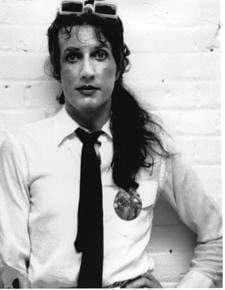With alter egos like the Art Star, the Woman from Malibu, Robin, Anna and Colleena, clearly dress-up was video artist Colin Campbell’s favourite game to play.
People Like Us: The Gossip of Colin Campbell has been a long time in the making. Jon Davies, curator of the retrospective (and frequent Xtra contributor), never knew Colin Campbell yet he clearly became very well acquainted with his shifting personas sifting through Campbell’s more than 50 video works. Contacted by Lisa Steele of Vtape and the Oakville Galleries to curate a comprehensive touring show Davies has succeeded in putting together an insightful overview of Campbell’s life and work. It’s the largest retrospective since Campbell’s death in 2001 at age 59 and spans his whole career beginning the early 1970s.
“In Colin’s work gossip is a force for bringing together and cohering a group of people into a social scene,” says Davies. “The play between truth and fiction is a fine line. When you’re being told a really great story it often doesn’t really matter if it’s true or not.”
Digitally restored, all Campbell’s videos are available to watch on various media players — good thing because this is an exhibit that takes time. Placing the show at Centennial Square, which is within a public library, is an inspired choice as people can enjoy a video here and there and come back another time throughout the run. A little overwhelming yet brilliant in its scope the gallery is infused with Campbell: Everywhere you turn there he is in various characters, lives, social groups and incarnations.
Campbell was surrounded by like-minded artists in the incestuous Toronto art scene on Queen St W in the early ’70s, ’80s and into the ’90s. Many are still working artists today like Steele (video artist and former creative and romantic partner), John Greyson (film/videomaker and former boyfriend), Almerinda Travarssos (film/videomaker), Margaret Moores (filmmaker), Johanna Householder (performance artist), Tanya Mars (visual artist), Rodney Werden (video artist) and George Hawkens (artist and Campbell’s boyfriend at the time of his death). The 1980 video Bad Girls is displayed prominently in its own room in the gallery. It’s probably the most fun and representative of the Toronto art scene of the time and clearly shows Campbell’s ability to bring people into his circle of gossip and art.
The exhibition is an exercise in space magic, creating a dynamic environment in which to view Campbell’s work. Davies says he thought of the show, “as a room full of faces in conversation that someone walking into the gallery would want to get to know better.” The highlights are the diptychs and triptychs. “These were attempts at setting up conversations between the work,” says Davies, “which seemed appropriate since it was about talk, socializing and self-presentation.” The most visually effective is the three large video screens entitled “Dangling by their Mouths” showing videos that, in Davies’ words, explore “the act and art of storytelling” — The Women Who Went Too Far (from 1984), LA Flex (1980), The Temperature in Lima (1976) and Culver City Limits and Conundrum Clinique (both from 1981).
From his time in Sackville where he got his first teaching position and his stint in LA where he created his art lab with Steele, to being ensconced in Toronto’s Queen West art scene, Campbell was queer in the true sense of the word, queer as in fluid. He was most famous for his charming charismatic personalities. “Campbell constructed the identities of his various personas and characters through who and what they talked about,” says Davies, “bringing the viewer into his fictional and social worlds.” Gender play was just part of his approach. “Campbell saw himself as bisexual and bigendered,” says Davies, noting however that “to Campbell identity was always slippery. He didn’t want to be held down.”
When watching his performances from the ’70s in such tapes as The Woman from Malibu or Sackville, I’m Yours he really becomes the character. “Campbell goes beyond just acting a role,” says Davies. “His performances seem very organic as if he is channelling the characters. His close collaboration with Lisa Steele was part of this character development. Their intense collaboration was part of the California time in Campbell’s life in the ’70s, where he and Steele created a laboratory experimenting with form, characters and storytelling, a pivotal time in his development as an artist.”
Davies calls Campbell “an iconic figure in Canada and in Toronto as much for his personality as for his video art.
“You can trace the history of video art by looking at his work. In the ’70s video art looked at the self playing with performance and self-presentation and in the ’80s it was focused more on playing with narrative and the codes of TV.
“Campbell’s work is very much of its time but has also maintained its relevance,” says Davies. “It isn’t just about the formal properties of video, it is about themes that will always be relevant: desire, gender, how to perform the self in the social world.
“Colin was a productive force that made things happen and inspired people to see the world in a different way.”
In a happy coincidence, the other Oakville Gallery at Gairloch Gardens (1306 Lakeshore Rd E) is showing the work of Gareth Long, a former student of Campbell’s. This exhibition is also worth a visit not only for the intriguing and compelling play of works that take conceptual ideas of video to a more material place but also to see the ongoing influence of Campbell’s legacy. Campbell was a mentor, a friend to many and, as this retrospective clearly illustrates, an important historical and relevant figure in both video art and queerdom of the past and present.

 Why you can trust Xtra
Why you can trust Xtra


